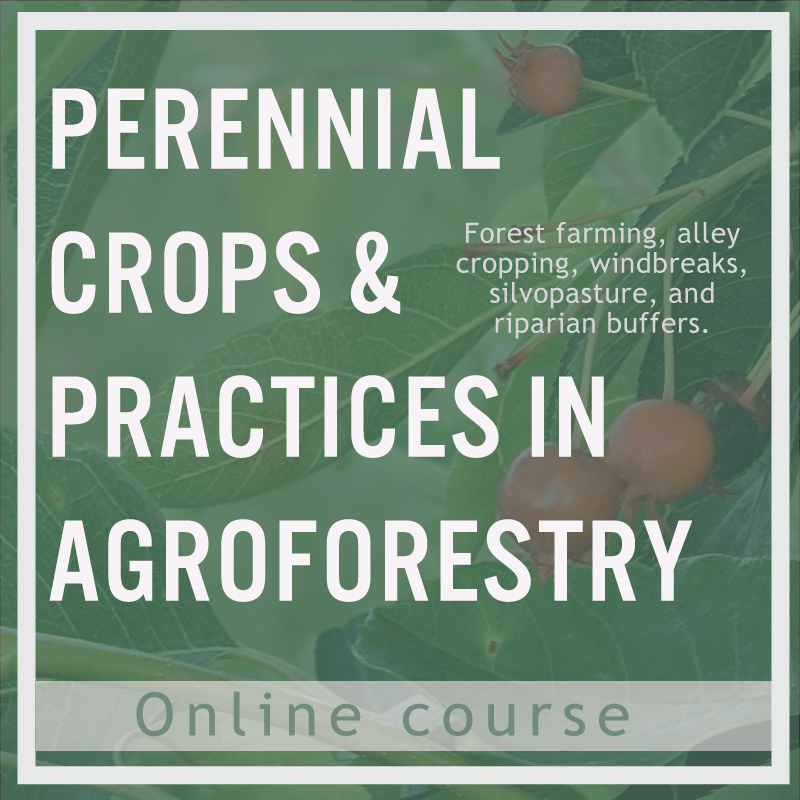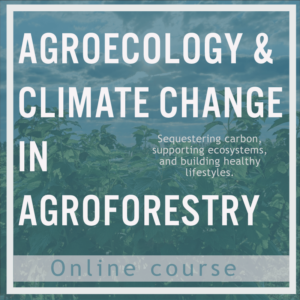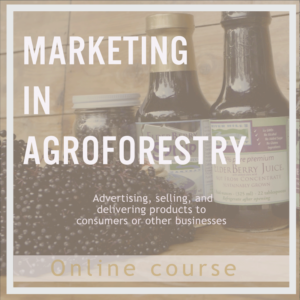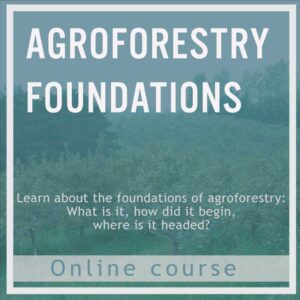Perennial Crops and Practices
$40.00
Deciding which crops and/or animals to include and how agroforestry will function at your site will be heavily influenced by the land characteristics as well as your preferences and resources. This course walks you through the characteristics, considerations, pros and cons, and economics of each of the five core US agroforestry practices and 12 of the most promising crops. We also designed reflection questions scattered throughout the course to help you identify your goals, preferences, and consider them in relation to learning about each practice and crops covered. Remember that agroforestry doesn’t have to be an all-or-nothing endeavor–it can be all-or-something!
Check out the longer description below for an outline.
Out of stock
The crops and practices people use in agroforestry vary across the landscape based on site characteristics (soils, climate, water availability, geomorphology) as well as the goals, values, and resources of each practitioner. For this reason, agroforestry looks different at each site and across landscapes. This course walks you through the characteristics, considerations, pros and cons, and economics of each of the five core US agroforestry practices and 12 of the most promising crops. Throughout the material, we provide opportunities to pause and reflect on the topics you are learning about as well as your personal preferences and goals.
Deciding which crops and/or animals to include and how agroforestry will function at your site will be heavily influenced by the site characteristics as well as your preferences and resources. This course will help you learn about the common agroforestry crops and practices and reflect on how agroforestry can work for your situation and goals. Once you’ve made a plan, implementing the plan can happen gradually. Remember that agroforestry doesn’t have to be an all-or-nothing endeavor--it can be all-or-something!
Outline:
- Lesson 1: Agroforestry Practices
- Farmer Voices
- Windbreaks
Reflection Questions
Supplemental Resources - Riparian Buffers
Reflection Questions
Supplemental Resources - Alley Cropping
Reflection Questions
Supplemental Resources - Silvopasture
Reflection Questions
Supplemental Resources - Forest Farming / Multi-story Cropping
Reflection Questions
Supplemental Resources
Reflection Questions
- Windbreaks
- Lesson 2: Perennial Fruit and Nut Crops
Farmer Voices
2.1 Apples
2.2 Aronia
2.3 Asian Pear
2.4 Black Currant
2.5 Black Walnut
2.6 Chinese Chestnuts
2.7 Elderberries
2.8 Hazelnuts
2.9 Honeyberry / Haskap
2.10 Pawpaw
2.11 Pecans
2.12 Saskatoon / Serviceberry / Juneberry
Reflection Questions
- Farmer Voices
Who should take this course? Those new to agroforestry, beginners, and dreamers. Throughout the course, we purposefully refer to people as agroforesters, practitioners, stewards etc., recognizing that not all people interested in beginning agroforestry projects identify as a farmer. Additionally, agroforestry projects can get started in rural and urban locations and everywhere in between. We also welcome those wanting to learn more about agroforestry in order to teach others the benefits of agroforestry. Regardless, whether you’re looking to diversify your income or landscape, or to help and strengthen your community, agroforestry has a lot to offer.
So let’s get started!





